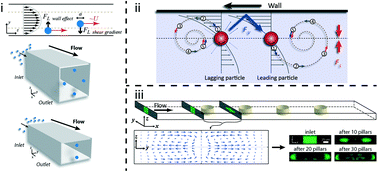Inertial microfluidic physics†
Abstract
Microfluidics has experienced massive growth in the past two decades, and especially with advances in rapid prototyping researchers have explored a multitude of channel structures, fluid and particle mixtures, and integration with electrical and optical systems towards solving problems in healthcare, biological and chemical analysis, materials synthesis, and other emerging areas that can benefit from the scale, automation, or the unique physics of these systems. Inertial microfluidics, which relies on the unconventional use of fluid inertia in microfluidic platforms, is one of the emerging fields that make use of unique physical phenomena that are accessible in microscale patterned channels. Channel shapes that focus, concentrate, order, separate, transfer, and mix particles and fluids have been demonstrated, however physical underpinnings guiding these channel designs have been limited and much of the development has been based on experimentally-derived intuition. Here we aim to provide a deeper understanding of mechanisms and underlying physics in these systems which can lead to more effective and reliable designs with less iteration. To place the inertial effects into context we also discuss related fluid-induced forces present in particulate flows including forces due to non-Newtonian fluids, particle asymmetry, and particle deformability. We then highlight the inverse situation and describe the effect of the suspended particles acting on the fluid in a channel flow. Finally, we discuss the importance of structured channels, i.e. channels with boundary conditions that vary in the streamwise direction, and their potential as a means to achieve unprecedented three-dimensional control over fluid and particles in microchannels. Ultimately, we hope that an improved fundamental and quantitative understanding of inertial fluid dynamic effects can lead to unprecedented capabilities to program fluid and particle flow towards automation of biomedicine, materials synthesis, and chemical process control.


 Please wait while we load your content...
Please wait while we load your content...